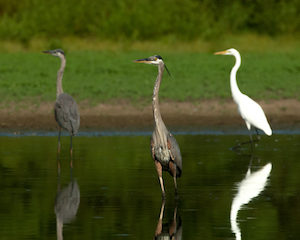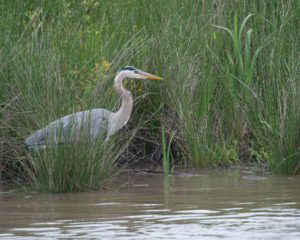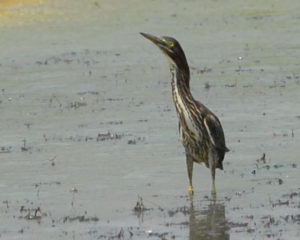Vol. 21 Issue 2, Summer 2016
By Emily B. Cook
When out for an early morning walk, there is nothing quite like the sense of serenity and peace that results from observing a wading bird gliding gracefully along the shoreline of a pond. It is often mesmerizing to watch as the bird places each foot with such intention and precision, seemingly in slow motion, and suspends itself in what appears to be an unnatural position as it patiently watches for prey.
 In eastern Loudoun, where the Chesapeake Bay Watershed is made up of an intricate web of rivers, streams and marshland, we are very fortunate that our area offers an abundance of habitat attractive to many waders such as herons, egrets and bitterns. Some of the more commonly seen waders in our local area include the Great Blue Heron, the Green Heron, and the Great Egret, but it is not uncommon to see or hear other varieties of herons, egrets and bitterns as well.
In eastern Loudoun, where the Chesapeake Bay Watershed is made up of an intricate web of rivers, streams and marshland, we are very fortunate that our area offers an abundance of habitat attractive to many waders such as herons, egrets and bitterns. Some of the more commonly seen waders in our local area include the Great Blue Heron, the Green Heron, and the Great Egret, but it is not uncommon to see or hear other varieties of herons, egrets and bitterns as well.
With an increasing focus on maintaining and preserving our wetlands here in Loudoun County, as well as the ongoing efforts to improve water quality and protect nesting and breeding areas during development, we make Loudoun desirable to these graceful and interesting birds. In fact, when comparing results from the 1985-89 Virginia Breeding Bird Atlas to the Loudoun County Bird Atlas project that wound up last year, we see a 6 percent increase in waterfowl of all kinds, including waders. In large part, this may be due to the increased availability of desirable habitat.
The Great Blue Heron (Ardea herodias) is the largest in the heron family, and is also the most abundant in North America as well as our immediate area. With a length of approximately 3-4 feet, and a wingspan that can easily reach 6 feet, they are an impressive bird on land as well as in the sky. Perhaps the most easily identifiable characteristic of the Great Blue Heron is the wisp of black feathers that sweep across the top of its piercing yellow eyes. Almost like a thick brow, these feathers extend past the back of its cream-colored head giving the impression of an elderly scholar. The heron’s long S-shaped neck is adorned with delicate, feathery cream plumage – a beautiful contrast to its grey-blue body.
 Great Blue Herons can be found year-round in Loudoun County. They are typically colonial nesters, building their nests from small twigs, grasses, mosses and leaves in large communal groups. Nests are high up in trees whenever possible to avoid predation by mammals and snakes and the same nests are often used year after year. A heron’s breeding and nesting area, which is referred to as a rookery or heronry, is quite an impressive sight – and is sometimes right under our noses. One of the largest rookeries in our area is located along Loudoun County Parkway, just south of Route 7, directly across from the One Loudoun development. There have been as many as 70 nests during any given breeding season and the trees are a flurry of activity during spring and summer. Another reported nesting location is in close proximity to the Route 340 bridge in Washington County, just over the Loudoun County line.
Great Blue Herons can be found year-round in Loudoun County. They are typically colonial nesters, building their nests from small twigs, grasses, mosses and leaves in large communal groups. Nests are high up in trees whenever possible to avoid predation by mammals and snakes and the same nests are often used year after year. A heron’s breeding and nesting area, which is referred to as a rookery or heronry, is quite an impressive sight – and is sometimes right under our noses. One of the largest rookeries in our area is located along Loudoun County Parkway, just south of Route 7, directly across from the One Loudoun development. There have been as many as 70 nests during any given breeding season and the trees are a flurry of activity during spring and summer. Another reported nesting location is in close proximity to the Route 340 bridge in Washington County, just over the Loudoun County line.
The Green Heron (Butorides virescens), which somewhat resembles a bittern in body style and manner, is a bit harder to spot among reeds and marsh grasses, but is well worth the effort. Stocky and shorter-legged compared to many others in the heron family, the Green Heron is no less beautiful. Deep iridescent green feathers adorn his head and back gradually transition to a rich, deep chestnut on his chest and underbelly. Occasionally, the Green Heron will stretch out his typically contracted neck and raise the feathers on his head into a crown, showing off his own regal elegance.
While some of his longer-legged cousins can wade a bit deeper in search of a meal, Green Herons prefer more densely vegetated shallows along waters’ edge where they can patiently wait for prey. They will, however, dive into deeper waters if an irresistible catch swims by. They are one of only a few birds that use tools and lures such as twigs, worms, feathers and other objects to attract and bait prey.
 A Green Heron is often heard before being seen; its loud “skeow” alarm call is associated with the chorus of the wetlands. With handsome good looks and a chatty personality, it is no surprise the Green Heron was selected as American Birding Association’s Bird of the Year for 2015. Green Heron pairs build stick nests in forks of trees, usually near water. They winter in Mexico and Central America and return each spring for breeding.
A Green Heron is often heard before being seen; its loud “skeow” alarm call is associated with the chorus of the wetlands. With handsome good looks and a chatty personality, it is no surprise the Green Heron was selected as American Birding Association’s Bird of the Year for 2015. Green Heron pairs build stick nests in forks of trees, usually near water. They winter in Mexico and Central America and return each spring for breeding.
Egrets are also frequently seen throughout Loudoun County, with the Great Egret (Ardea alba) being more prevalent. Great Egrets are easily spotted because of their alabaster white plumage and long, graceful lines. They can be distinguished from their slightly smaller cousin the Snowy Egret (Egretta thula) by the Great Egret’s yellow bill and dark feet. As with other wading birds, they are most easily viewed at the water’s edge, but the egret has also been known to forage among cattle in a flooded pasture or boggy field following a heavy rain. Great Egret pairs nest individually as well as in colonies, and occasionally communally with other waders. As with most waders, they prefer to nest high off the ground to avoid predators. Locally, one reported nesting area is along the Potomac River near Harper’s Ferry for those interested in getting a closer look.
Once hunted for their pristine white feathers, the Great Egret’s numbers were substantially diminished in the late 1800s but protections put in place during the early 1900s allowed populations to gradually recover. Today, generally declining water quality and diminishing wetlands are problematic for egrets and other waders but efforts to respect existing wetland areas, limit public access to waterways and protect breeding grounds, have had a tremendously positive effect.
Several other waders are often spotted in our county periodically, but are not as abundantly represented. These include the American Bittern, Lesser Bittern, Snowy Egret, Tricolored Heron, Black- and Yellow-Crowned Night Herons, and Cattle Egrets. None have established breeding colonies here in Loudoun County yet, but with populations as close by as Fairfax County, it is entirely possible with our continued efforts to create and protect wetlands that we may see these waders establish nesting here in the future.
Many locations throughout Loudoun offer bird enthusiasts an opportunity to see wading birds. In eastern Loudoun, marshy areas near Trump National Golf Course and the adjacent parkland that is part of the Potomac Heritage National Scenic Trail often host Great Blue Heron, Green Heron and egrets and bitterns. Further west, the Broadlands Wetlands and Dulles Greenway Wetlands Mitigation Project are great places to see waders. Of course, anywhere along the shallow edge of the Potomac will often result in viewing opportunities of waders and other species of waterfowl as well.
The key to spotting waders, or really wildlife of any kind, is by practicing persistence, patience and peace. If you wish to commune with and observe wading birds, then you need to respect and maintain the tranquility of their environment. Sharp, loud noises or quick movements startle these patient hunters long before you even know they were there. Some waders are more elusive than others, and some are just the masters of camouflage hiding in plain sight, but if you know how and where to look for them, you will find consistent success and reward.
Sources:
http://www.pbase.com/btblue/wading_birds
http://www.pwconserve.org/wildlife/birds/
https://www.audubon.org/bird-family/herons-egrets-bitterns
http://thewebsiteofeverything.com/animals/birds/Ciconiiformes/
http://www.birds-of-north-america.net/
https://www.allaboutbirds.org/guide/

